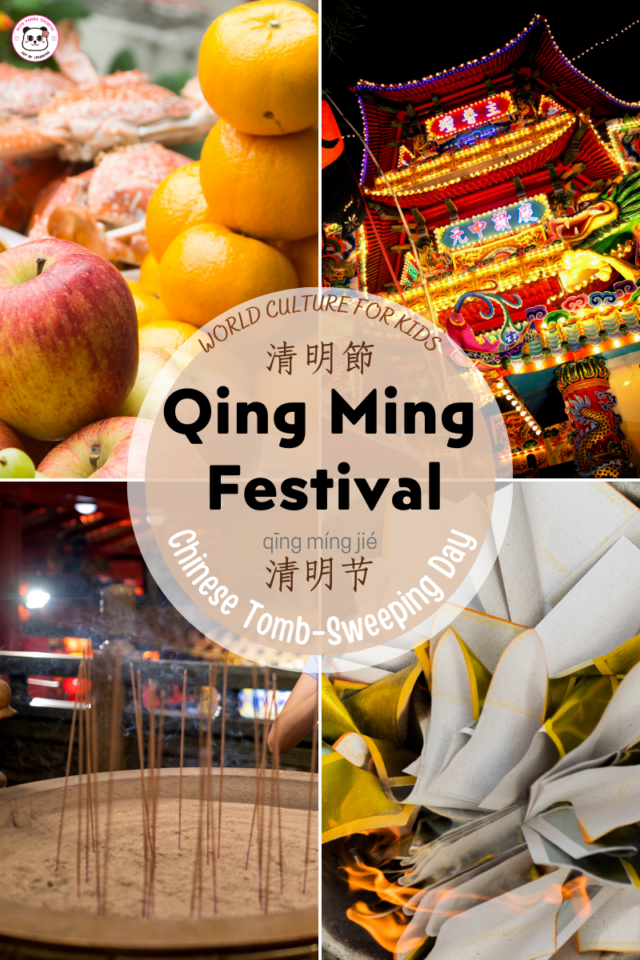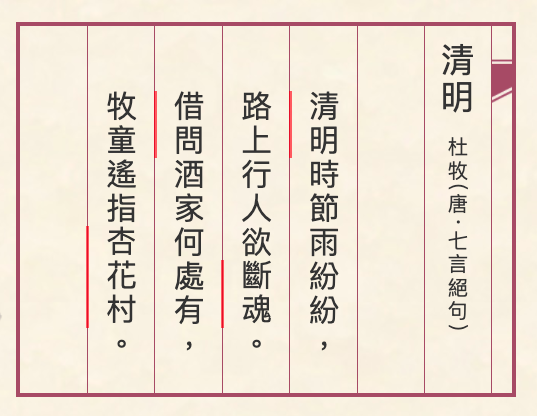.It 
Qing Ming Festival for Kids
Qing Ming Jie is the Qing Ming Festival. In Chinese, it is Qīng Míng Jié 清明節|清明节. It is also widely known as Tomb-Sweeping Day in the Chinese community. This day always falls on the third lunar month, and on the Western calendar, it is celebrated on April 5.
For world cultural exploration, you can compare the similarities and differences between the following world festivals:
-
Qing Ming Jie 清明節 | 清明节 (Qing Ming Festival)
-
Day of the Dead (Dia de Muertos)
-
All Saints Day
-
Halloween 萬聖節 | 万圣节
-
Chinese Hungry Ghost Festival 鬼月中元節 | 鬼月中元节
-
Japanese Obon お盆 or Bon 盆
When it comes to teaching our students and children about cultural differences, we know it is important to recognize and respect various customs and traditions. Today we are looking at one of the four major Chinese cultural festivals – Qing Ming Jie (Qing Ming Festival) is celebrated in Chinese territories and by their diasporas.
This significant day is dedicated to remembering the passing of loved ones and ancestors. This makes it a dignified and solemn time. It’s crucial to note that Chinese people do not say “Happy Qing Ming Festival” during this time. It is not considered appropriate. It’s important to share with our students and children the significance of the cultural traditions of the Qing Ming Jie and to encourage them to appreciate and understand diverse perspectives. By doing so, we can help foster a culture of inclusivity and respect within our classrooms and communities.
We can guide children to experience or explore cultural differences and the significance of various traditions. The Qing Ming Festival, observed in China and Taiwan, plays a crucial role in honoring ancestors and loved ones who have passed away.
This public holiday has also been adopted by Chinese communities worldwide, with families coming together to commemorate their ancestors and perform a tradition known as “Qing Ming Tomb Sweeping – qīng míng sǎo mù 清明掃墓.” During this time, families visit cemeteries to clean up their loved ones’ tombs, which is considered a solemn and respectful occasion.
To fully appreciate the significance of the Qing Ming Festival, it’s essential to understand expressions like “Qing Ming Festival – Qīng míng jié 清明節” and “Cemetery – mù yuán 墓園.” By teaching our children about cultural traditions and practices like the Qing Ming Festival, we can help them develop an appreciation for diversity and promote respect for others or their own heritage beliefs, and customs.
Let’s take the time to learn about and celebrate the traditions of different cultures and communities, and encourage our children to do the same. By doing so, we can foster curiosity for world culture.
Poetry
is a beautiful art form that allows us to express emotions and ideas in a unique and creative way. The poem “Qing Ming” 清明 by Du Mu 杜牧, a poet from the Tang dynasty (618-907) in China, is an excellent example of this art form. This poem captures the essence of the Qing Ming Festival, a time when people show deep sorrow for their loved ones who have passed away.

Image credit: RTHK.HK | Qing Ming Festival for Kids – A Poem to Experience
As we read the poem, we can feel the sorrow and grief of the people walking on the road in the rain, symbolizing the sadness and melancholy of the occasion. The poem’s title “Qing Ming” refers to the festival. Here is the English translation, Pinyin, and Chinese of the poem.
Stanza 1
On the day of Qing Ming it rained and rained
Qīng míng shí jié yǔ fēn fēn
清明時節雨紛紛,| 清明时节雨纷纷,
Stanza 1.2
people walking on the road showed their deep sorrow
lù shàng xíng rén yù duàn hún
路上行人欲斷魂。| 路上行人欲断魂。
Stanza 2.1
When asked where to find a tavern
Jiè wèn jiǔ jiā hé chù yǒu,
Stanza 2.2
the young cowherds directed me to the Xing Hua village.
mù tóng yáo zhǐ Xìng Huā cūn.
牧童遙指杏花村。|牧童遥指杏花村。
In the second stanza, we see the poet asking for directions to a tavern and the young cowherds directing him to the Xing Hua village. This part of the poem adds a touch of realism to the poem and also highlights the importance of community and coming together during the Qing Ming Festival.
Overall, Du Mu’s “Qing Ming” poem is a powerful and moving expression of the emotions associated with the festival. By exploring this poem, we can gain a deeper understanding of Chinese culture and appreciate the beauty of Chinese poetry.
Traditions
The Qing Ming Festival is a time honoring traditions in China and Taiwan. While Chinese people usually avoid going to cemeteries, during the Qing Ming Festival, they pay their respects to their ancestors by cleaning up their tombs. The festival falls on April 5th of the Gregorian calendar each year. During this time, you can expect to see heavy traffic on the way to cemeteries. Qing Ming, which means “clean and bright.”
Families often spend hours cleaning up their loved ones’ graves. They might also retouch headstone inscriptions and worship their ancestors by lighting up incense, burning paper money, and displaying fruit, food, and flowers for their ancestors to “enjoy.” In recent years, families have started burning paper mansions, paper laptops, paper smartphones, and even paper luxury cars as offerings to their ancestors.
The Origin Story
Qing Ming Festival has an interesting origin story. It started from the Cold Food Festival (Hán shí jié 寒食節|寒食节), which was held in memory of Jiè zhī tuī, a loyal and devoted nobleman who served Duke Wen of Jin during his exile in the Chinese Spring and Autumn Period. The Duke did not award Jie for his loyalty and devotion, so Jie retired and lived in the forest with his mother. The Duke ordered the forest to be set on fire to force Jie to come out of hiding but instead killed him and his mother.
Every year, Duke Wen commemorated Jie, and these commemorations eventually became the Cold Food Festival, which later evolved into the Qing Ming Festival. During the Cold Food Festival (or Qing Ming Festival), people eat chūn bǐng (春餅|春饼), also called chūn juǎn (春捲|春卷) or rùn bǐng (潤餅|润饼), a crepe wrapped in thin wraps with cold fillings. This dish is related to the Cold Food Festival, which shares similarities with the Qing Ming Festival.
The Art – Up the River During Qing Ming 清明上河圖
The Qing Ming Festival is not only a time for honoring ancestors but also a celebration of Chinese culture and art. One of the most famous cultural relics associated with the festival is the painting known as 清明上河圖 (qīng míng shàng hé tú), which translates to Up the River During Qing Ming.
Zhang Ze Duan 張擇端 | 张泽端 (1085–1145) created this masterpiece during the Song dynasty (960-1279). It was over 900 years ago. The painting is 10.0 inches in height and an impressive 5.74 yards long. It depicts a bustling street scene with 814 people, 28 boats, 60 animals, 30 buildings, 20 vehicles, 8 sedan chairs, and 170 trees.
The original painting is housed in the National Palace Museum in Taiwan. It continues to inspire awe in visitors. For a more immersive experience, you and your child can watch the award-winning animated digital version of the painting and see if you can spot all the animals in motion!
Qing Ming Festival and Chinese Art offer an opportunity to dive into the fascinating world of Chinese culture. It’s an essential part of learning the Chinese language. Explore cultural festivals with children can deepen their understanding of the language and the people who speak it.
Up the River During Qing Ming is a 900-year-old painting by Zhang Ze Duan. It is a testament to the rich history of Chinese art and culture. This delicate masterpiece captures the spirit of the Qing Ming Festival. By introducing your child to this painting, you can expand their worldview and help them become more empathetic and culturally aware individuals.
Don’t miss the chance to explore more Chinese culture. Sign up for Miss Panda’s blog and receive email updates. Let’s continue the journey of Chinese language and cultural exploration together!
Qing Ming Festival for Kids • Qing Ming Festival for Kids • Qing Ming Festival for Kids • Author: Amanda Hsiung-Blodgett